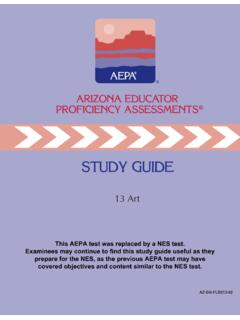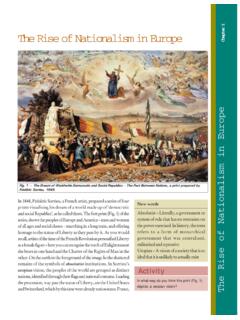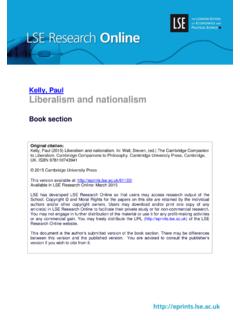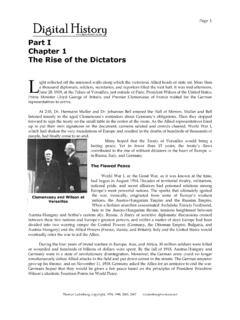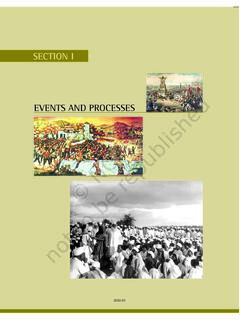Transcription of TM - aepa.nesinc.com
1 TMTM TMTMAZ-SG-FLD005-0105 HistoryThis AEPA test was replaced by a NES test. Examinees may continue to find this study guide useful as they prepare for the NES, as the previous AEPA test may have covered objectives and content similar to the NES should be advised that this study guide, including many of theexcerpts used herein, is protected by federal copyright 2005 by National Evaluation Systems, Inc. (NES )"AEPA," "Arizona Educator Proficiency Assessments," and the "AEPA" logo are trademarks ofthe Arizona Department of Education and National Evaluation Systems, Inc.
2 (NES )."NES " and its logo are registered trademarks of National Evaluation Systems, Inc. TMTABLE OF CONTENTSF ield 05: HistoryPART 1: GENERAL INFORMATION ABOUT THE AEPA AND TEST PREPARATIONAN OVERVIEW OF THE 1-1 Test Development ProcessCharacteristics of the AEPATest AdministrationHow AEPA Test Scores Are Computed and ReportedHOW TO PREPARE FOR THE 1-3 Study the Test ObjectivesFocus Your StudiesIdentify ResourcesDevelop Study TechniquesAnswer the Practice QuestionsReview the Sample Answer Sheet and Written Response BookletTest DirectionsSample Answer SheetSample Written Response BookletWHAT TO EXPECT THE DAY OF THE 1-12 The Morning of the AdministrationAt
3 The Test SiteSAMPLE TEST OBJECTIVES AND 1-13 Organization of the Test ObjectivesQuestion Formats and StrategiesSelected-Response-Question FormatsPerformance Assignment FormatsEvaluation of the Sample Written Performance Assignment ResponsePART 2: FIELD-SPECIFIC 2-1 TEST 2-2 PRACTICE 2-8 ANSWER 2-20 STUDY GUIDE ORDER FORMTMPART 1:GENERAL INFORMATION ABOUTTHE AEPA AND TEST PREPARATIONPart 1 of this study guide is contained in a separate PDF file. Click the link below to view orprint this section:General Information About the AEPA and Test PreparationArizona Educator Proficiency Assessments Study Guide2-1 TMPART 2:FIELD-SPECIFIC INFORMATIONF ield 05: HistoryINTRODUCTIONThis section includes a list of the test objectives, practice questions, and an answer key for the selected-response objectives.
4 As noted earlier, the test objectives are broad, conceptual statements that reflect theknowledge, skills, and understanding an entry-level educator needs to practice effectively in Arizona list of test objectives for each test field is the only source of information about what a specific test willcover and therefore should be studied questions. The practice selected-response questions and practice performance assignments includedin this section are designed to give you an introduction to the nature of the questions included in the AEPA tests.
5 The practice questions represent the various types of questions you may expect to see on an actual test;however, they are not designed to provide diagnostic information to help you identify specific areas ofindividual strengths and weaknesses or to predict your performance on the test as a you answer the practice questions, you may wish to use the sample answer sheet and sample WrittenResponse Booklet provided in Part 1 to acquaint yourself with these materials. Use the answer key locatedafter the practice questions to check your answers.
6 Sample responses are provided immediately followingeach written performance assignment. The sample responses in this guide are for illustrative purposes written response should be your original work, written in your own words, and not copied orparaphrased from some other help you identify how the test objectives are measured, the objective statement to which the questioncorresponds is listed in the answer key. When you are finished with the practice questions, you may wish togo back and review the entire list of test objectives and descriptive statements for your test Educator Proficiency Assessments Study GuideTEST OBJECTIVESF ield 05: HistorySUBAREAS:1.
7 Concepts and Skills2. World History3. United States and Arizona HistoryCONCEPTS AND SKILLS0001 Understand key historical terms and example: defining historical terms and concepts ( , culture, nation-state, revolution); usingthese terms and concepts to analyze historical developments; and demonstrating familiarity withvarious historical research example: demonstrating familiarity with a variety of source materials; distinguishing betweenprimary and secondary sources; recognizing uses of basic reference tools; and applying proceduresfor accessing information from electronic , analyze, and evaluate historical example: organizing information into coherent outlines; interpreting data presented intimelines; analyzing cause-and-effect relationships; drawing inferences from a variety of sources;determining whether historical generalizations are supported by credible evidence.
8 And evaluatingthe reliability and point of view of various source visual representations of historical example: deriving historical information from various sources ( , maps, graphs, charts, tables,paintings, political cartoons, photographs); and using that information to analyze general historicaldevelopments and specific historical basic geographic skills, and understand the relationship between geography and example: demonstrating an understanding of geographic terms; interpreting maps; analyzinghow geography has influenced the development of civilizations ( , the development of ancientEgyptian civilization and the annual flooding of the Nile River); and recognizing the effects ofhuman modifications of the physical environment on the development of nations and societies( , the environmental consequences of expansion onto the Great Plains).
9 WORLD HISTORY0006 Understand the impact of the environment, science, and technology on the development of example: recognizing environmental factors and major scientific and technological advancesthat have contributed to the development of civilization; analyzing social, economic, and politicalfactors that have encouraged or discouraged scientific and technological innovation; and examiningthe positive and negative social consequences of the agricultural, scientific, industrial, andinformation Educator Proficiency Assessments Study Guide2-30007 Understand the structure and characteristics of cultures and example: analyzing processes that led to the development of early agricultural societies;recognizing the variety of ways in which organized human groups have ensured survival ( ,met the need for food, shelter, clothing, and physical security).
10 Demonstrating knowledge of theorganization of preindustrial and industrial societies; comparing the political, economic, social,religious, and cultural characteristics of civilizations in various regions; and analyzing relationshipsamong economic organization, political authority, and social the doctrines, philosophical assumptions, and ethical value systems of world example: demonstrating knowledge of the historical development and principal teachings ofworld religions ( , Hinduism, Buddhism, Judaism, Christianity, Islam); recognizing the impactof religious institutions in various societies; and analyzing the effects of religious beliefs andinstitutions on historical eras and the historical development of early Mediterranean and Middle Eastern example: demonstrating knowledge of the political and economic organization and culturaldevelopment of early Mediterranean and Middle Eastern civilizations ( , Sumerian, Egyptian,Greek, Persian, Roman).




